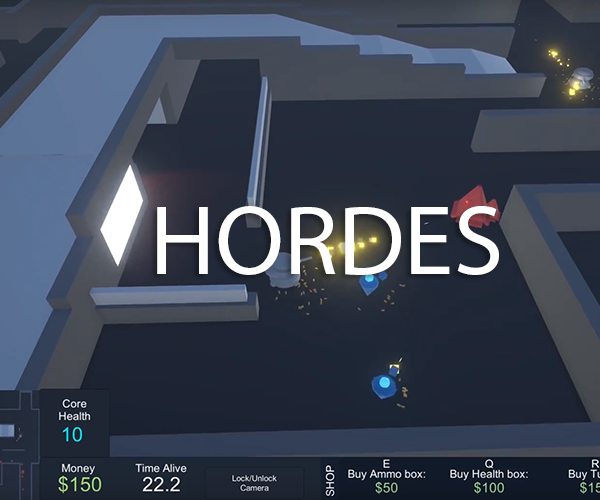
Hordes
Isometric wave-based strategy game
Hordes is a 3D isometric real-time strategy game based on quick decisions and unit maintenance to defend against infinite waves of enemies.
Through various unit and turret maintenance, infinite hordes of enemies, and automatic targeting, I intend to create an “Item drop management” gameplay system that is challenging and replayable where more focus is placed on the maintaining of said units than controlling their direct positions and targets.
Gameplay is strategic and exciting, focusing on movement, resource management, progression, level awareness, and combat.
Download Game View full documentationMy Intent for this prototype.
Through various unit and turret maintenance, infinite hordes of enemies, and automatic targeting, I intend to create an “Item drop management” gameplay system that is challenging and replayable where more focus is placed on the maintaining of said units than controlling their direct positions and targets.
Research & Thesis.
My goal for this project is to create a complex strategy system revolving around the player controlling the environment and purchasable drops and equipment that aids the friendly units against hordes of enemies. Instead of directly controlling every friendly unit, players manage the ammo, and health of each unit and can even place auto-firing turrets and lock doors and environmental hazards. The objective of this systems is to create a gameplay loop where the player faces alternative challenges on top of typical unit management, not only are players managing resources but also keeping back an endless massive hoard in real-time.
Most top-down strategy games that focus around unit maintenance are based around minute detailed movements and setting units similarly to old-school army men and action figures. However, many of these unit-focused games do not pay too much attention to the direct variables of the units and instead how they move in the scene and if not they are typically turn-based. Instead I wanted to focus on the variables contained within each unit and the drops that can be placed by the player in a real-time setting, essentially mixing real-time strategy and tower defence gameplay.
One of the main objectives of this system was to create a fast-paced exciting tactical environment where players would assist their units instead of directly controlling them. In order to maximize my ability to achieve this milestone, I focused my research on the varying ways that many developers of strategy games handle their player cameras, and unit variables to understand how to properly incorporate them into the system. I looked at how games with similar units handle their internal components such as the ammo, health, or stamina of the unit and then how the player directly affects that component. In most of the games that I found such as the XCOM or Total War series, the player has little direct control over the components of the unit and instead determines where the unit will look or be in the world. I decided to create a system that does the opposite to understand if it is a valuable option for a game and how players would interact when restricted in that sort of way.
Next I viewed how the player camera was used in tactical / strategy games, and how / if it could be directly interacted with or changed by the player. What I found was that many games such as Age of Empires or Stellaris allowed the player to zoom in and out of the battlefield and even rotate the camera to view units from afar or animated battles up close but not change how the camera moves within the game. I assumed that this was because the isometric 3D camera angle has been a hallmark of strategy games for many years being successful in allowing players to see across the large maps and unit counts. This camera standardization pushed me to add extra functionality to the camera, allowing players to switch between a standard strategy game camera, and a “rocket league inspired” locked camera that automatically follows each friendly unit keeping them in the boundaries of the screen.